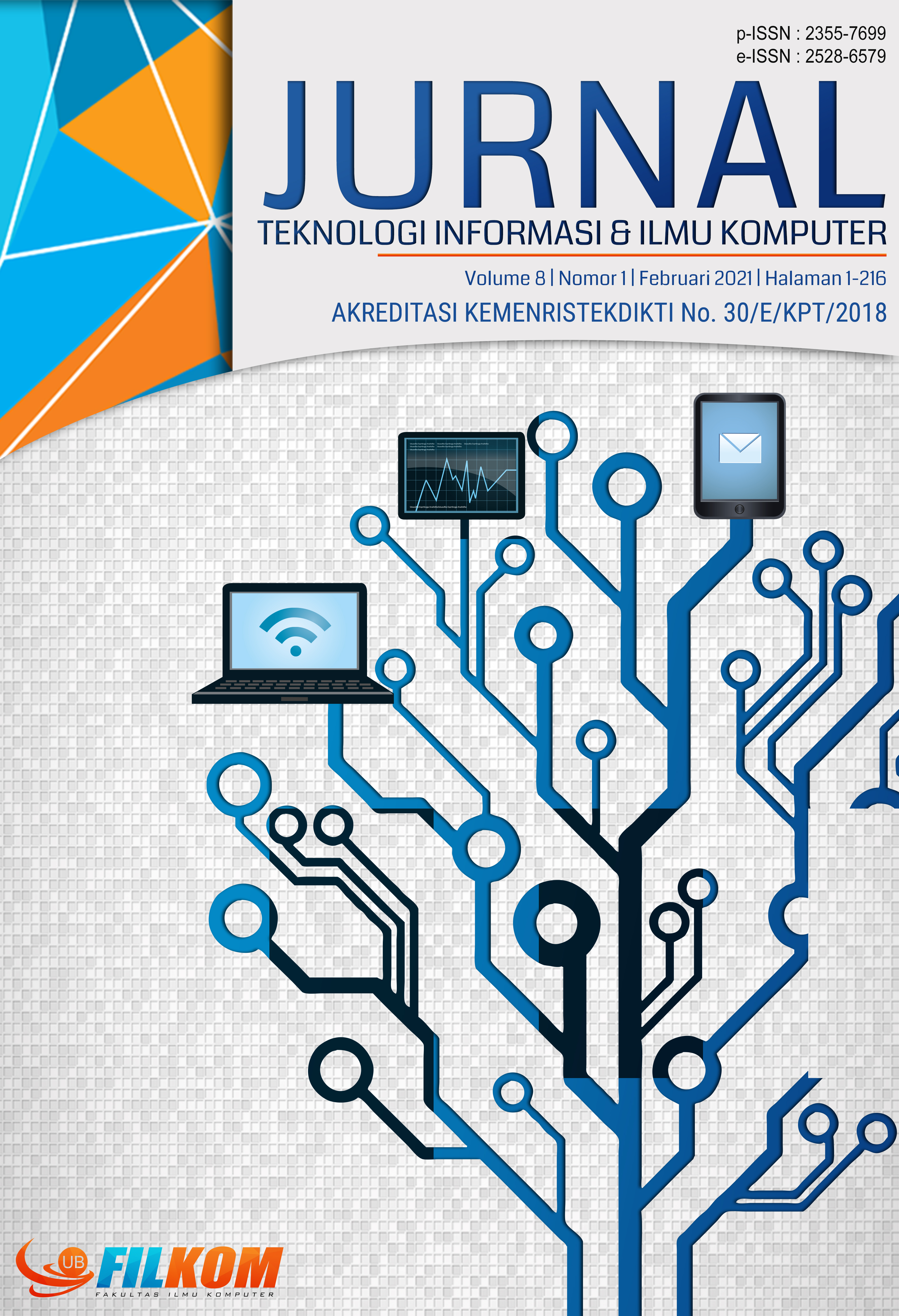Eliminasi Non-Topic Menggunakan Pemodelan Topik untuk Peringkasan Otomatis Data Tweet dengan Konteks Covid-19
DOI:
https://doi.org/10.25126/jtiik.0814324Abstrak
Akun twitter, seperti Suara Surabaya, dapat membantu menyebarkan informasi tentang COVID-19 meskipun ada bahasan lainnya seperti kecelakaan, kemacetan atau topik lain. Peringkasan teks dapat diimplementasikan pada kasus pembacaan data twitter karena banyaknya jumlah tweet yang tersedia, sehingga akan mempermudah dalam memperoleh informasi penting terkini terkait COVID-19. Jumlah variasi bahasan pada teks tweet mengakibatkan hasil ringkasan yang kurang baik. Oleh karena itu dibutuhkan adanya eliminasi tweet yang tidak berkaitan dengan konteks sebelum dilakukan peringkasan. Kontribusi penelitian ini adalah adanya metode pemodelan topik sebagai bagian tahapan dalam serangkaian proses eliminasi data. Metode pemodelan topik sebagai salah satu teknik eliminasi data dapat digunakan dalam berbagai kasus namun pada penelitian ini difokuskan pada COVID-19. Tujuannya adalah untuk mempermudah masyarakat memperoleh informasi terkini secara ringkas. Tahapan yang dilakukan adalah pra-pemrosesan, eliminasi data menggunakan pemodelan topik dan peringkasan otomatis. Penelitian ini menggunakan kombinasi beberapa metode word embedding, pemodelan topik dan peringkasan otomatis sebagai pembanding. Ringkasan diuji menggunakan metode ROUGE dari setiap kombinasi untuk ditemukan kombinasi terbaik dari penelitian ini. Hasil pengujian menunjukkan kombinasi metode Word2Vec, LSI dan TextRank memiliki nilai ROUGE terbaik yaitu 0.67. Sedangkan kombinasi metode TFIDF, LDA dan Okapi BM25 memiliki nilai ROUGE terendah yaitu 0.35.
Abstract
Twitter accounts, such as Suara Surabaya, can help spread information about COVID-19 even though there are other topics such as accidents, traffic jams or other topics. Text summarization can be implemented in the case of reading Twitter data because of the large number of tweets available, making it easier to obtain the latest important information related to COVID-19. The number of discussion variations in the tweet text results in poor summary results. Therefore, it is necessary to eliminate tweets that are not related to the context before summarization is carried out. The contribution to this research is the topic modeling method as part of a series of data elimination processes. The topic modeling method as a data elimination technique can be used in various cases, but this research focuses on COVID-19. The aim is to make it easier for the public to obtain current information in a concise manner. The steps taken in this study were pre-processing, data elimination using topic modeling and automatic summarization. This study uses a combination of several word embedding methods, topic modeling and automatic summarization as a comparison. The summary is tested using the ROUGE method of each combination to find the best combination of this study. The test results show that the combination of Word2Vec, LSI and TextRank methods has the best ROUGE value, 0.67. While the combination of TFIDF, LDA and Okapi BM25 methods has the lowest ROUGE value, 0.35.
Downloads
Referensi
GAO, D., LI, W., CAI, X., ZHANG, R., & OUYANG, Y. 2017. Sequential summarization: A full view of Twitter trending topics. Social Media Content Analysis: Natural Language Processing and Beyond, 375–399. https://doi.org/10.1142/9789813223615_0024
GENSIM. 2020. Gensim. https://radimrehurek.com/gensim/
HAGEN, L. 2018. Content analysis of e-petitions with topic modeling: How to train and evaluate LDA models? Information Processing & Management, 54(6), 1292–1307.
HANNIGAN, T. R., HAANS, R. F. J., VAKILI, K., TCHALIAN, H., GLASER, V. L., WANG, M. S., KAPLAN, S., & JENNINGS, P. D. 2019. Topic modeling in management research: Rendering new theory from textual data. Academy of Management Annals, 13(2), 586–632.
HU, Y. H., CHEN, Y. L., & CHOU, H. L. 2017. Opinion mining from online hotel reviews – A text summarization approach. Information Processing and Management, 53(2), 436–449. https://doi.org/10.1016/j.ipm.2016.12.002
JIWANGGI, M. A., & ADRIANI, M. 2016. Topic Summarization of Microblog Document in Bahasa Indonesia using the Phrase Reinforcement Algorithm. Procedia Computer Science. https://doi.org/10.1016/j.procs.2016.04.054
JOSHI, A., FIDALGO, E., ALEGRE, E., & FERNÁNDEZ-ROBLES, L. 2019. SummCoder: An unsupervised framework for extractive text summarization based on deep auto-encoders. Expert Systems with Applications, 129, 200–215. https://doi.org/10.1016/j.eswa.2019.03.045
MOHAMMED, S. H., & AL-AUGBY, S. 2020. LSA & LDA Topic Modeling Classification: Comparison study on E-books. Indonesian Journal of Electrical Engineering and Computer Science, 19(1).
MUSTAMIIN, M., GHOZALI, A. L., & SIFA, M. L. 2018. Peringkasan Multi-dokumen menggunakan Metode Pengelompokkan berbasis Hirarki dengan Multi-level Divisive Coefficient. Jurnal Teknologi Informasi Dan Ilmu Komputer, 5(6), 697. https://doi.org/10.25126/jtiik.2018561149
PARK, J., & OH, H.-J. 2017. Comparison of topic modeling methods for analyzing research trends of archives management in korea: Focused on lda and hdp. Journal of Korean Library and Information Science Society, 48(4), 235–258.
PRABHAKAR KAILA, D., PRASAD, D. A. V, & OTHERS. 2020. Informational flow on Twitter--Corona virus outbreak--topic modelling approach. International Journal of Advanced Research in Engineering and Technology (IJARET), 11(3).
PURWITASARI, D., FATICHAH, C., ARIESHANTI, I., & HAYATIN, N. 2016. K-medoids algorithm on Indonesian Twitter feeds for clustering trending issue as important terms in news summarization. Proceedings of 2015 International Conference on Information and Communication Technology and Systems, ICTS 2015, 95–98. https://doi.org/10.1109/ICTS.2015.7379878
SHARIFI, B. P., INOUYE, D. I., & KALITA, J. K. 2014. Summarization of twitter microblogs. Computer Journal, 57(3), 378–402. https://doi.org/10.1093/comjnl/bxt109
WANG, F., ORTON, K., WAGENSELLER, P., & XU, K. 2018. Towards understanding community interests with topic modeling. IEEE Access, 6, 24660–24668.
Unduhan
Diterbitkan
Terbitan
Bagian
Lisensi

Artikel ini berlisensi Creative Common Attribution-ShareAlike 4.0 International (CC BY-SA 4.0)
Penulis yang menerbitkan di jurnal ini menyetujui ketentuan berikut:
- Penulis menyimpan hak cipta dan memberikan jurnal hak penerbitan pertama naskah secara simultan dengan lisensi di bawah Creative Common Attribution-ShareAlike 4.0 International (CC BY-SA 4.0) yang mengizinkan orang lain untuk berbagi pekerjaan dengan sebuah pernyataan kepenulisan pekerjaan dan penerbitan awal di jurnal ini.
- Penulis bisa memasukkan ke dalam penyusunan kontraktual tambahan terpisah untuk distribusi non ekslusif versi kaya terbitan jurnal (contoh: mempostingnya ke repositori institusional atau menerbitkannya dalam sebuah buku), dengan pengakuan penerbitan awalnya di jurnal ini.
- Penulis diizinkan dan didorong untuk mem-posting karya mereka online (contoh: di repositori institusional atau di website mereka) sebelum dan selama proses penyerahan, karena dapat mengarahkan ke pertukaran produktif, seperti halnya sitiran yang lebih awal dan lebih hebat dari karya yang diterbitkan. (Lihat Efek Akses Terbuka).















